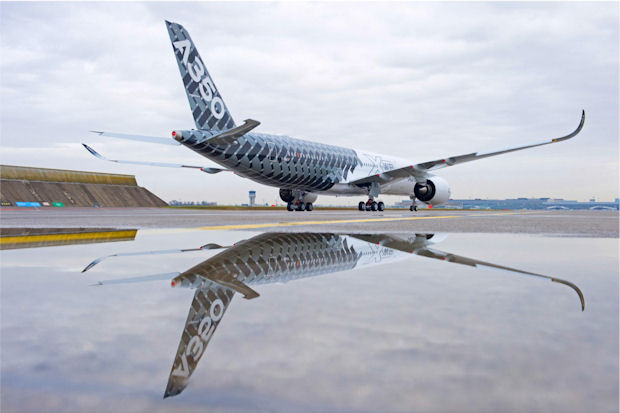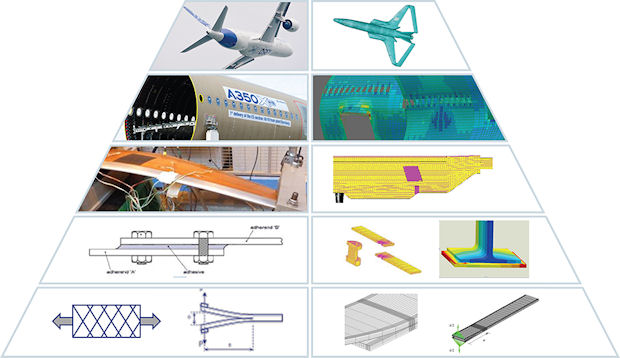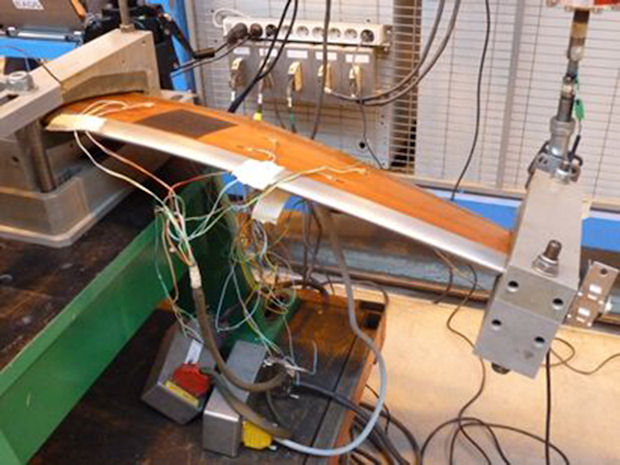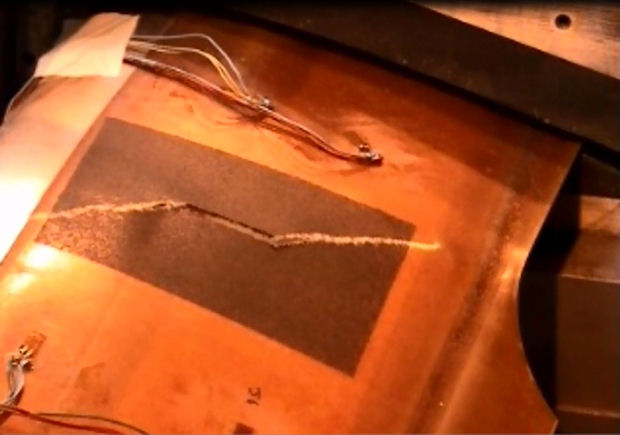
An Airbus A350. Image courtesy of Airbus
Latest News
October 1, 2014
One of today’s biggest challenges for aircraft manufacturers is reducing fuel consumption and emissions. And one of the best ways to accomplish that is by increasing the structural efficiency and reliability of aircraft and using new, lighter composite materials to minimize weight.
Within this framework, engineers need to maintain control of the design by predicting all types of potential defects in the structural components made of composites. Compared to metals, composites exhibit very specific failure modes. To provide safe designs that fully exploit the potential of these new materials, aircraft stress engineers need to identify possible delamination, as well as damages that may appear inside the plies of the layered composite structures.
Additionally, the nonlinear geometric effects of thin-walled composite structures are complex to analyze and cannot be ignored. Advanced expertise in nonlinear analysis is required to obtain accurate results so that realistic safety margins can be determined.
Airbus Group Innovations (formerly EADS Innovation Works) is the corporate research and technology department of Airbus Group. Its primary mission is to develop technology to support industrial innovations within its divisions: Airbus, Airbus Defence and Space (formerly Cassidian and Astrium) and Airbus Helicopters (formerly Eurocopter).
 The building block approach, including the composite structure and virtual and experimental material testing.
The building block approach, including the composite structure and virtual and experimental material testing.Its secondary objective is to share competencies among these commercial entities to help Airbus Group in an increasingly competitive global environment. Airbus Group Innovations primarily works with Airbus and Airbus Helicopters on its composite analysis research, which requires an innovative and advanced concept for design and deployment in new aircraft programs.
Virtual testing is an essential tool to decrease the number of physical tests on composite components and to support aircraft certification. Siemens PLM Software plays a vital role in this process for Airbus Group Innovations by providing LMS Samtech Samcef software, a finite element analysis (FEA) package dedicated to mechanical and structural virtual prototyping. LMS Samcef is used in numerous industrial fields, for everything from basic to advanced projects.
Indeed, during the past 20 years, the LMS Samtech software development team has built a strong relationship with Airbus Group Innovations, especially in the area of composite technologies.
Providing a Foundation
With more than 35 years of experience working with leaders in the aerospace industry, Airbus Group Innovations experts perform research and assist aircraft original equipment manufacturers (OEMs) with the implementation of dedicated structural analysis technology and optimization scenarios, as well as solid predictive solutions for composites. Airbus Group Innovations improves its knowledge by enabling the simulation of composite material damages so it can analyze large composite thin-walled structures. For full-fledged programs, efficiency improvement projects include developing dedicated and improved models, which take into account modeling possible failures in the composite structure.
“The Airbus Group Innovations team dedicated to advanced composite analysis and simulation is used to incorporating engineers from the French university Ecole Normale Supérieure de Cachan (ENS Cachan), especially from its Laboratoire de Mécanique et Technologie (LMT Cachan),” says Didier Guedra-Desgeorges, vice president and head of the Technical Capabilities Center Structure Engineering, Production & Aeromechanics at Airbus Group Innovations. “The very high level of the research programs and the number of new composite material laws and models for composite structure damage developed by LMT Cachan explains the strong relationship between us.”
Guedra-Desgeorges adds that the Laboratoire de Mécanique et d’Acoustique, Aix-Marseille University (LMA Marseille), another French university laboratory working in the same field, is another research partner of Airbus Group Innovations: “The LMS Samtech development team is the cornerstone of these partnerships, contributing to the dissemination of these new material laws thanks to the implementation of these advanced concepts into its LMS Samcef solver.”
Gaining a Deeper Understanding
Given the growing competitive pressure, it’s important that the Airbus Group reacts quickly to the needs of the market by designing products right the first time, and by using new methodologies for integrating advanced modeling of composites.
“Thanks to the implementation into LMS Samcef of advanced composite material laws developed in collaboration with LMT Cachan and LMA Marseille, Airbus Group gained much deeper physical insights, thus extending the gap with its competitors by positioning itself as the first and leading research department able to offer such advanced expertise,” says Guedra-Desgeorges.
The formulation of the selected model has been extensively validated against experimental results. It allows for taking into account the different kinds of failure modes and damages of composite materials, as well as the interdependencies of these phenomena.
“The successful implementation of these laws in the nonlinear LMS Samcef finite element solver was completed with the support of the Siemens PLM Software team,” says Serge Maison Le-Poec, head of Structure Analysis at Airbus Group Innovations. “Even if openness is available via material user routines, a native implementation in commercial software provides a more reliable solution.”
Maison Le-Poec notes that advanced numerical regularization techniques have been set up to preserve good convergence properties of such highly nonlinear analyses, including strong discontinuities. “The fact that LMS Samcef software provides a robust, state-of-the-art technology environment in an industrial context is strategic for us,” he says.
This new functionality has been successfully tested by Airbus Helicopters for the prediction of the nonlinear structural behavior of a composite blade, including a transverse crack. The precise correlation between the simulation and the physical test results confirm that it is possible to analyze complex scenarios on composite structures. Thanks to the demonstration of its methods and models reliability and the extension of the spectrum of analyses to real-life complex behaviors on composite structures, Airbus Group Innovations has positioned itself as a leader when applying for existing and new industrial programs.
Realizing Clear Benefits
The trend is to use simulation of composite components in parallel or as a complement to physical testing. Within the full aircraft design process, the use of simulation tools is now virtually essential to satisfy the requirements of the certification authorities, while saving time and money. The accurate analysis models for composites provide a better understanding of the physics of failure. With the knowledge of what the effects of a failure are on the composite structure, better designs can be proposed with more precise safety margins.
This provides significant benefits to aircraft OEMs. The definition of more accurate safety margins by the stress department of aircraft OEMs enables lighter weight composite structures and a reduction in costs. Together with the support and expertise of the LMS Samtech development team, Airbus Group Innovations is working on the deployment of massive parallel computing based on the LMS Samcef nonlinear solver, to run large-scale models for composite damage analysis.
“Further validations are running with Airbus within the European MAAXIMUS project,” says Maison-Le-Poec, referring to the More Affordable Aircraft through eXtended, Integrated and Mature nUmerical Sizing consortium comprised of 57 partners. “Airbus Group and LMS Samtech software experts are also partners in several research and development (R&D) projects on composite damage analysis.”
Guedra-Desgeorges says that Airbus Group Innovations is recognized for having set a high standard for engineering service activities to provide tailor-made solutions.
“The fast adoption of its methods by the aviation industry will improve the industrial design process,” he adds. Because composite material behavior and life duration are different from the traditional metallic material fracture mechanics phenomena, current air-worthiness methodologies are being adapted to take into account virtual testing of specific failure effects on aircraft composite structures.”
More Info
Subscribe to our FREE magazine, FREE email newsletters or both!
Latest News











